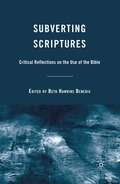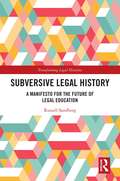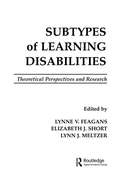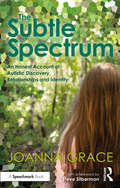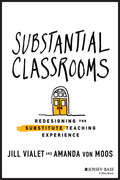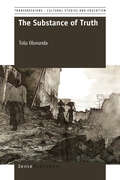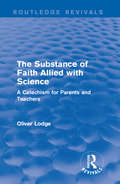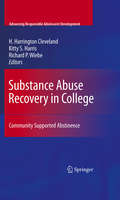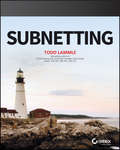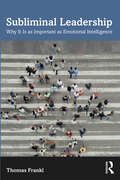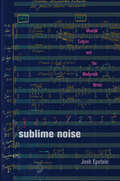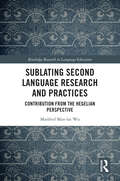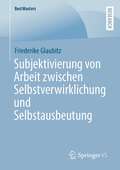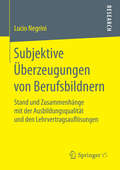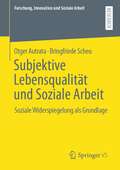- Table View
- List View
Subverting Scriptures: Critical Reflections on the Use of the Bible
by B. BenedixThis collection seeks to fill the interdisciplinary space that addresses when, why, and how writers strategically reference the Bible for subversive or re-evaluative purposes. It explores the specific biblical pieces used this subversion, and why they are used, with reference to many contemporary sources.
Subversive Legal History: A Manifesto for the Future of Legal Education (Transforming Legal Histories)
by Russell SandbergProvocative, audacious and challenging, this book rejuvenates not only the historical study of law and but also the role of Law Schools by asking which stories we tell and which stories we forget. It argues that a historical approach to law should be at the beating heart of the Law School curriculum. Far from being archaic, elitist and dull, historical perspectives on law are and should be subversive. Comparison with the past underscores: how the law and legal institutions are not fixed but are constructed; that every line drawn in the law and everything the law holds as sacred is arbitrary; and how the environment into which law students are socialised is a historical construct. A subversive approach is needed to highlight, question, de-construct and re-construct the authored nature of the law, revealing that that legal change on a larger scale is possible. Subversive Legal History is not a type of Legal History but is a characteristic. It describes a legal method that should not be the preserve only of specialist legal historians but rather should be part of the toolkit of all law students, teachers and researchers. The book will be essential reading for all who work and study in Law Schools, proposing a radical new approach not only to the historical study of law but to the content, purpose and ambition of legal education. A subversive approach can revolutionise Law Schools providing a more ambitious legal education which is grounded in the socio-legal reality, helping to ensure that today’s law students are better equipped to be the professionals and citizens of tomorrow.
Subversive Legal History: A Manifesto for the Future of Legal Education (Transforming Legal Histories)
by Russell SandbergProvocative, audacious and challenging, this book rejuvenates not only the historical study of law and but also the role of Law Schools by asking which stories we tell and which stories we forget. It argues that a historical approach to law should be at the beating heart of the Law School curriculum. Far from being archaic, elitist and dull, historical perspectives on law are and should be subversive. Comparison with the past underscores: how the law and legal institutions are not fixed but are constructed; that every line drawn in the law and everything the law holds as sacred is arbitrary; and how the environment into which law students are socialised is a historical construct. A subversive approach is needed to highlight, question, de-construct and re-construct the authored nature of the law, revealing that that legal change on a larger scale is possible. Subversive Legal History is not a type of Legal History but is a characteristic. It describes a legal method that should not be the preserve only of specialist legal historians but rather should be part of the toolkit of all law students, teachers and researchers. The book will be essential reading for all who work and study in Law Schools, proposing a radical new approach not only to the historical study of law but to the content, purpose and ambition of legal education. A subversive approach can revolutionise Law Schools providing a more ambitious legal education which is grounded in the socio-legal reality, helping to ensure that today’s law students are better equipped to be the professionals and citizens of tomorrow.
Subtypes of Learning Disabilities: Theoretical Perspectives and Research
by Lynne V. Feagans Elizabeth J. Short Lynn J. MeltzerAlthough experts agree that various types of learning disabilities do exist, few attempts have been made to classify learning disabled children into subtypes. The editors of this collection feel that the lack of subcategorization has frustrated previous research efforts to obtain a generalizable body of knowledge in the field. To meet this critical need for definitive information, this book presents basic reviews and theoretical approaches used to subtype learning disabled children -- ranging from a behavior genetics approach to a dimensional approach. It also demonstrates actual research methods utilizing theoretical approaches.
Subtypes of Learning Disabilities: Theoretical Perspectives and Research
by Lynne V. Feagans Elizabeth J. Short Lynne Vernon-Feagans Lynn J. MeltzerAlthough experts agree that various types of learning disabilities do exist, few attempts have been made to classify learning disabled children into subtypes. The editors of this collection feel that the lack of subcategorization has frustrated previous research efforts to obtain a generalizable body of knowledge in the field. To meet this critical need for definitive information, this book presents basic reviews and theoretical approaches used to subtype learning disabled children -- ranging from a behavior genetics approach to a dimensional approach. It also demonstrates actual research methods utilizing theoretical approaches.
The Subtraction Book: A Progression of Subtraction Skills (PDF)
by Jillian CockingsPrimary School Subtraction book
The Subtle Spectrum: An Honest Account of Autistic Discovery, Relationships and Identity
by Joanna GraceAm I autistic, or is autism something I suff er from? Should I come out, to my friends, to my family, to the people I work with? Should I drop the mask? How can I explain my experience to a neurotypical world? The Subtle Spectrum off ers an exploration into the postdiagnostic landscape of autism and the transformative journey of one woman, from her awareness of diff erence, through acceptance, to an embracing of autistic identity and beyond as she questions the cultural identity of autism. Joanna’s narrative is enriched with insights from a range of diverse contributors, creating a refl ective opportunity for people to gain a better understanding of the experience of being autistic. With a focus on relationships built across a neurodiverse divide, the book considers topics as broad as mental health, work opportunities and abuse, weaving theory and research with lived experience to give true insight into the life of an autistic person, both pre- and post- diagnosis. Written with a raw and engaging honesty, this is a crucial read for anybody who identifi es as autistic as an adult or teenager, or anyone looking to support somebody exploring diagnosis. It will also provide an invaluable insight for social workers, educators and relationships counsellors working with autistic people.
The Subtle Spectrum: An Honest Account Of Autistic Discovery Relationships And Identity
by Joanna GraceAm I autistic, or is autism something I suff er from? Should I come out, to my friends, to my family, to the people I work with? Should I drop the mask? How can I explain my experience to a neurotypical world? The Subtle Spectrum off ers an exploration into the postdiagnostic landscape of autism and the transformative journey of one woman, from her awareness of diff erence, through acceptance, to an embracing of autistic identity and beyond as she questions the cultural identity of autism. Joanna’s narrative is enriched with insights from a range of diverse contributors, creating a refl ective opportunity for people to gain a better understanding of the experience of being autistic. With a focus on relationships built across a neurodiverse divide, the book considers topics as broad as mental health, work opportunities and abuse, weaving theory and research with lived experience to give true insight into the life of an autistic person, both pre- and post- diagnosis. Written with a raw and engaging honesty, this is a crucial read for anybody who identifi es as autistic as an adult or teenager, or anyone looking to support somebody exploring diagnosis. It will also provide an invaluable insight for social workers, educators and relationships counsellors working with autistic people.
Substantial Classrooms: Redesigning the Substitute Teaching Experience
by Jill Vialet Amanda von MoosTransform Your School’s Substitute Teaching Experience Just like everything else, substitute teaching is about to undergo a big change. In Substantial Classrooms: Redesigning the Substitute Teaching Experience, authors Jill Vialet and Amanda von Moos usher in a new era of innovation in substitute teaching. Threaded with concrete and actionable ways to improve the experience of substitute teaching for administrators, students, and the teachers themselves, Substantial Classrooms is a leading voice for innovation and renewal in substitute teaching. Instead of viewing substitute teachers as a placeholder in an educator’s absence, this book encourages readers to view substitute teachers as vital resources that diversify the typical classroom learning experience. While other books look only at making a bad situation bearable, this book re-examines substitute teaching with an eye towards reinventing it as a unique and valuable part of students’ educational experience. Key themes of Substantial Classrooms include: How substitute teaching works today Applying human-centered design to create change in legacy systems like substitute teaching Concrete and inspiring examples of different models for substitute teaching, for example, reimagining it as paid fieldwork for aspiring teachers. In addition to these key themes, every chapter includes stories and techniques from dynamic and innovative educational practitioners. This must-have guide to substitute teaching can improve schools everywhere and revolutionize the way educators, school and district leaders, colleges, and community partners view the experience of substitute teaching as a lever to positively impact schools.
Substantial Classrooms: Redesigning the Substitute Teaching Experience
by Jill Vialet Amanda von MoosTransform Your School’s Substitute Teaching Experience Just like everything else, substitute teaching is about to undergo a big change. In Substantial Classrooms: Redesigning the Substitute Teaching Experience, authors Jill Vialet and Amanda von Moos usher in a new era of innovation in substitute teaching. Threaded with concrete and actionable ways to improve the experience of substitute teaching for administrators, students, and the teachers themselves, Substantial Classrooms is a leading voice for innovation and renewal in substitute teaching. Instead of viewing substitute teachers as a placeholder in an educator’s absence, this book encourages readers to view substitute teachers as vital resources that diversify the typical classroom learning experience. While other books look only at making a bad situation bearable, this book re-examines substitute teaching with an eye towards reinventing it as a unique and valuable part of students’ educational experience. Key themes of Substantial Classrooms include: How substitute teaching works today Applying human-centered design to create change in legacy systems like substitute teaching Concrete and inspiring examples of different models for substitute teaching, for example, reimagining it as paid fieldwork for aspiring teachers. In addition to these key themes, every chapter includes stories and techniques from dynamic and innovative educational practitioners. This must-have guide to substitute teaching can improve schools everywhere and revolutionize the way educators, school and district leaders, colleges, and community partners view the experience of substitute teaching as a lever to positively impact schools.
The Substance of Truth (Transgressions #71)
by Tolu OlorundaTolu Olorunda is a cultural critic whose work has regularly appeared on AlterNet, Black Commentator, CounterPunch, Truthout, and several other publications including ColorLines magazine, The Nation magazine, and Wiretap magazine. His book, The Substance of Truth, takes a frank look into what has become of a society that touts grand and lofty ideals which it often fails to fulfill. With essays addressing issues as broad as the education system, 21st century media culture, Hip-Hop culture, youth culture, neoliberalism, and moral poverty, Olorunda argues the days ahead would darken in promise if rigorous action isn’t soon applied to rectify the way people think, how they respond to their surroundings, and the decisions they take to make the world better than it stands today. This struggle, he insists, could define whether or not a livable future would exist for the most vulnerable of all—children, whose plights are increasingly cast aside and ignored. From the book: “At risk of appearing alarmist, it’s easy to ignore all the warning signs hanging around us that suggest the clock is ticking fast—real fast!—and that time left for due action is short. But if life for the next generation should contain some semblance of sanity—where life itself means more than shopping malls and commodities, where Power stands accountable to the demands of communities—all fear of coming across hyperbolic would have to give way to the realities staring us down. The risk also extends to coming across Pollyannaish, as though all the impurities and iniquities holding hostage society can be cured with essays or lectures. But we cannot afford to let this moment slip by unattended, unengaged. The problems number endless—and so do the possibilities. And at no other moment has a generation been more fortunate, with the ease of technology, to make miracles happen amidst frightening circumstances. At no other moment has the clarion call blared this clearly and loudly.”
The Substance of Faith Allied with Science: A Catechism for Parents and Teachers (Routledge Revivals)
by Oliver LodgeOriginally published in 1907, this book provides information to parents and teachers wishing to teach their children about Christianity as well as science. Lodge details his fear of mandatory secularism in schools and advises how to instruct children in science without allowing any doubt of Christian doctrine and stresses the importance of reconciliation between religion and science for future generations. This title will be of interest to students of Education and Religion.
The Substance of Faith Allied with Science: A Catechism for Parents and Teachers (Routledge Revivals)
by Oliver LodgeOriginally published in 1907, this book provides information to parents and teachers wishing to teach their children about Christianity as well as science. Lodge details his fear of mandatory secularism in schools and advises how to instruct children in science without allowing any doubt of Christian doctrine and stresses the importance of reconciliation between religion and science for future generations. This title will be of interest to students of Education and Religion.
Substance Abuse Recovery in College: Community Supported Abstinence (Advancing Responsible Adolescent Development)
by H. Harrington Cleveland Richard P. Wiebe Kitty S. HarrisSubstance Abuse Recovery in College explains in authoritative detail what collegiate recovery communities are, the types of services they provide, and their role in the context of campus life, with extended examples from Texas Tech University’s influential CSAR (Center for the Study of Addiction and Recovery) program. Using data from both conventional surveys and end-of-day daily Palm Pilot assessments as well as focus groups, the book examines community members’ experiences. In addition, the importance of a positive relationship between the recovery community and the school administration is emphasized. Topics covered include: The growing need for recovery services at colleges. How recovery communities support abstinence and relapse prevention. Who are community members and their addiction and treatment histories. Daily lives of young adults in a collegiate recovery community. Challenges and opportunities in establishing recovery communities on campus. Building abstinence support into an academic curriculum. This volume offers clear insights and up-close perspectives of importance to developmental and clinical child psychologists, social workers, higher education policymakers, and related professionals in human development, family studies, student services, college health care, and community services.
Subnetting
by Todd LammleMaster the fundamental concept at the heart of professional networking Subnetting is the aspiring network professional’s guide to the concepts and practices at the core of the field. By dividing a single physical network into smaller subnetworks, you gain greater control of performance, access, and security. While the concept is simple, the actual practice is complex—yet it is an essential skill for networking professionals, and a major skill tested on the CCENT and CompTIA Network+ exams. This book shows you everything you need to know about constructing IP addresses, VSLM, and route summarization to help you build your skill set on a strong foundation. The IPv4 address has 32 bits available, which can be divided into host ID and network ID; the number of bits assigned to the network ID determines the balance between total subnetworks and devices allowed—the trick is determining the most efficient balance for a particular network. Subnetting allows you to borrow bits from the host to allow for more networks, and subnet masks are used to determine switching and routing priority. This book delves into the mechanisms and practices you need to know, including networking fundamentals, rules of IP addresses, supernetting, variable length subnet mask, IPv6, and more: Master the fundamental topic at the heart of the Cisco Certified Entry Networking Technician and CompTIA Network+ certifications Improve network performance using subnetworks to avoid high-usage “clogs” Utilize network partitioning to confine breaches or viruses and improve security Construct efficient solutions to problems of allocation and range With clear guidance from an industry expert and a practical perspective geared toward real-world situations, Subnetting offers an outstanding introduction to this essential foundational concept.
Subnetting
by Todd LammleMaster the fundamental concept at the heart of professional networking Subnetting is the aspiring network professional’s guide to the concepts and practices at the core of the field. By dividing a single physical network into smaller subnetworks, you gain greater control of performance, access, and security. While the concept is simple, the actual practice is complex—yet it is an essential skill for networking professionals, and a major skill tested on the CCENT and CompTIA Network+ exams. This book shows you everything you need to know about constructing IP addresses, VSLM, and route summarization to help you build your skill set on a strong foundation. The IPv4 address has 32 bits available, which can be divided into host ID and network ID; the number of bits assigned to the network ID determines the balance between total subnetworks and devices allowed—the trick is determining the most efficient balance for a particular network. Subnetting allows you to borrow bits from the host to allow for more networks, and subnet masks are used to determine switching and routing priority. This book delves into the mechanisms and practices you need to know, including networking fundamentals, rules of IP addresses, supernetting, variable length subnet mask, IPv6, and more: Master the fundamental topic at the heart of the Cisco Certified Entry Networking Technician and CompTIA Network+ certifications Improve network performance using subnetworks to avoid high-usage “clogs” Utilize network partitioning to confine breaches or viruses and improve security Construct efficient solutions to problems of allocation and range With clear guidance from an industry expert and a practical perspective geared toward real-world situations, Subnetting offers an outstanding introduction to this essential foundational concept.
Subliminal Leadership: Why It Is as Important as Emotional Intelligence
by Thomas FranklUnderstanding the power of subliminal influence makes or breaks leaders. What is it that subliminally motivates people to give their best, not just what’s in their job description? How do you build an outstanding team? (Spoiler: it’s not just by putting the best people in a team.) The answer lies in the power of subliminal influence. This book explains in a clear and accessible way this important, yet little known and understood, area of psychology and leadership. As Emotional Intelligence helped managers and leaders to understand the importance of empathy in the workplace, Subliminal Leadership takes us to the next level by explaining how influence through non-verbal communication mostly happens below the threshold of our conscious awareness: subliminal forms of body language and communication which influence other people's attitudes, thinking and behavior – and which may boost, or undermine a leader's authority, the performance of teams or the quality of key customer relationships. Readers will learn how we unconsciously communicate and how we positively or negatively influence other people in the process. Understanding subliminal influence will help people in, or aspiring towards, leadership positions to build trust, understand others’ emotions, make better decisions, and strengthen professional relationships. Based on recent scientific research in disciplines as diverse as psychology, evolutionary biology, anthropology, medicine, neuroscience, and management studies, the book offers a breakthrough, multidisciplinary approach to influence and leadership. This book is for everyone interested in the psychological, biological, and medical dimensions of leadership.
Subliminal Leadership: Why It Is as Important as Emotional Intelligence
by Thomas FranklUnderstanding the power of subliminal influence makes or breaks leaders. What is it that subliminally motivates people to give their best, not just what’s in their job description? How do you build an outstanding team? (Spoiler: it’s not just by putting the best people in a team.) The answer lies in the power of subliminal influence. This book explains in a clear and accessible way this important, yet little known and understood, area of psychology and leadership. As Emotional Intelligence helped managers and leaders to understand the importance of empathy in the workplace, Subliminal Leadership takes us to the next level by explaining how influence through non-verbal communication mostly happens below the threshold of our conscious awareness: subliminal forms of body language and communication which influence other people's attitudes, thinking and behavior – and which may boost, or undermine a leader's authority, the performance of teams or the quality of key customer relationships. Readers will learn how we unconsciously communicate and how we positively or negatively influence other people in the process. Understanding subliminal influence will help people in, or aspiring towards, leadership positions to build trust, understand others’ emotions, make better decisions, and strengthen professional relationships. Based on recent scientific research in disciplines as diverse as psychology, evolutionary biology, anthropology, medicine, neuroscience, and management studies, the book offers a breakthrough, multidisciplinary approach to influence and leadership. This book is for everyone interested in the psychological, biological, and medical dimensions of leadership.
Sublime Noise: Musical Culture and the Modernist Writer (Hopkins Studies in Modernism)
by Josh EpsteinWhen Stravinsky’s Rite of Spring premiered in Paris in 1913, the crowd rioted in response to the harsh dissonance and jarring rhythms of its score. This was noise, not music. In Sublime Noise, Josh Epstein examines the significance of noise in modernist music and literature. How—and why—did composers and writers incorporate the noises of modern industry, warfare, and big-city life into their work?Epstein argues that, as the creative class engaged with the racket of cityscapes and new media, they reconsidered not just the aesthetic of music but also its cultural effects. Noise, after all, is more than a sonic category: it is a cultural value judgment—a way of abating and categorizing the sounds of a social space or of new music. Pulled into dialogue with modern music’s innovative rhythms, noise signaled the breakdown of art’s autonomy from social life—even the "old favorites" of Beethoven and Wagner took on new cultural meanings when circulated in noisy modern contexts. The use of noise also opened up the closed space of art to the pressures of publicity and technological mediation.Building both on literary cultural studies and work in the "new musicology," Sublime Noise examines the rich material relationship that exists between music and literature. Through close readings of modernist authors, including James Joyce, T. S. Eliot, Edith Sitwell, E. M. Forster, and Ezra Pound, and composers, including George Antheil, William Walton, Erik Satie, and Benjamin Britten, Epstein offers a radically contemporary account of musical-literary interactions that goes well beyond pure formalism. This book will be of interest to scholars of Anglophone literary modernism and to musicologists interested in how music was given new literary and cultural meaning during that complex interdisciplinary period.
Sublime Noise: Musical Culture and the Modernist Writer (Hopkins Studies in Modernism)
by Josh EpsteinWhen Stravinsky’s Rite of Spring premiered in Paris in 1913, the crowd rioted in response to the harsh dissonance and jarring rhythms of its score. This was noise, not music. In Sublime Noise, Josh Epstein examines the significance of noise in modernist music and literature. Howâ€�and whyâ€�did composers and writers incorporate the noises of modern industry, warfare, and big-city life into their work?Epstein argues that, as the creative class engaged with the racket of cityscapes and new media, they reconsidered not just the aesthetic of music but also its cultural effects. Noise, after all, is more than a sonic category: it is a cultural value judgmentâ€�a way of abating and categorizing the sounds of a social space or of new music. Pulled into dialogue with modern music’s innovative rhythms, noise signaled the breakdown of art’s autonomy from social lifeâ€�even the "old favorites" of Beethoven and Wagner took on new cultural meanings when circulated in noisy modern contexts. The use of noise also opened up the closed space of art to the pressures of publicity and technological mediation.Building both on literary cultural studies and work in the "new musicology," Sublime Noise examines the rich material relationship that exists between music and literature. Through close readings of modernist authors, including James Joyce, T. S. Eliot, Edith Sitwell, E. M. Forster, and Ezra Pound, and composers, including George Antheil, William Walton, Erik Satie, and Benjamin Britten, Epstein offers a radically contemporary account of musical-literary interactions that goes well beyond pure formalism. This book will be of interest to scholars of Anglophone literary modernism and to musicologists interested in how music was given new literary and cultural meaning during that complex interdisciplinary period.
Sublating Second Language Research and Practices: Contribution from the Hegelian Perspective (Routledge Research in Language Education)
by Manfred Man-fat WuWu’s book provides an innovative perspective on, and recommendations for, the major aspects of second language (L2) teaching from a Hegelian anthro-philosophical perspective. Language is social in nature and is related to the larger social milieu. Hegelian philosophy of language complements existing research and theories on L2 learning by not only equipping them with a systematic framework but also broadening their scope. In Hegelian philosophy, language not only has its individual and interpersonal dimensions but is also related to the community, society, and morality. The Hegelian perspective also suggests a number of functions of L2 which have either been neglected or rejected by L2 researchers. This book highlights these neglected elements such as intersubjectivity, mutual recognition, universalization and objectivization of inner subjectivity of individuals, as well as moral enhancement. These concepts generate insights on the teaching and learning of L2. Wu’s volume also covers how the Hegelian anthro-philosophical perspective can help to re-interpret research results on L2 learner characteristics that are related to L2 learning to date such as L2 identity and autonomy. The book offers an alternative research paradigm, teaching philosophy, pedagogical implications, and suggestions for scholars, practitioners, and students in the professional field of L2 teaching.
Sublating Second Language Research and Practices: Contribution from the Hegelian Perspective (Routledge Research in Language Education)
by Manfred Man-fat WuWu’s book provides an innovative perspective on, and recommendations for, the major aspects of second language (L2) teaching from a Hegelian anthro-philosophical perspective. Language is social in nature and is related to the larger social milieu. Hegelian philosophy of language complements existing research and theories on L2 learning by not only equipping them with a systematic framework but also broadening their scope. In Hegelian philosophy, language not only has its individual and interpersonal dimensions but is also related to the community, society, and morality. The Hegelian perspective also suggests a number of functions of L2 which have either been neglected or rejected by L2 researchers. This book highlights these neglected elements such as intersubjectivity, mutual recognition, universalization and objectivization of inner subjectivity of individuals, as well as moral enhancement. These concepts generate insights on the teaching and learning of L2. Wu’s volume also covers how the Hegelian anthro-philosophical perspective can help to re-interpret research results on L2 learner characteristics that are related to L2 learning to date such as L2 identity and autonomy. The book offers an alternative research paradigm, teaching philosophy, pedagogical implications, and suggestions for scholars, practitioners, and students in the professional field of L2 teaching.
Subjektivierung von Arbeit zwischen Selbstverwirklichung und Selbstausbeutung (BestMasters)
by Friederike GlaubitzDieses Buch gibt Einblicke in die historische Entwicklung des Wandels von Arbeitskraft aus Sicht der arbeits- und industriesoziologischen Forschung und beleuchtet dabei die Gründe für die spätmodernen Anforderungen an und Einforderungen von Lohnarbeitenden. Aufgrund von Strukturwandel und einem Paradigmenwechsel in der Arbeitsorganisation ab den 1970 / 80er Jahren erfordert die postmoderne Lohnarbeit von den Arbeitssubjekten verstärkt das Einbringen von subjektiven Potenzialen. Dabei sind z. B. Selbststrukturierung, -kontrolle und -ökonomisierung, aber auch eine unternehmerische Denkweise und motiviertes Arbeitshandeln gefragt, um die Tätigkeiten der heutigen Zeit ausführen zu können. Ab dem gleichen Zeitpunkt werden auf Beschäftigtenseite Ansprüche laut, die ebenfalls auf die Einbringung subjektiver Potenziale in die Lohnarbeit abzielen: Selbstentfaltung und -verwirklichung, die Vereinbarkeit von Arbeit und Privatleben sowie das ‚qualitativ gute Leben‘ werden gefordert. Beide Tendenzen werden arbeitswissenschaftlich als ‚doppelte Subjektivierung‘ zusammengefasst und in der vorliegenden Arbeit im Detail betrachtet sowie Chancen und Risiken dieser Entwicklung erörtert.
Subjektive Überzeugungen von Berufsbildnern: Stand und Zusammenhänge mit der Ausbildungsqualität und den Lehrvertragsauflösungen
by Lucio NegriniDie empirische Untersuchung zeigt am Beispiel von Koch- und Malerbetrieben der Deutschschweiz, dass die subjektiven Überzeugungen der BerufsbildnerInnen die betriebliche Ausbildungsqualität beeinflussen können, welche wiederum als eine Art Schutzfaktor gegen Lehrvertragsauflösungen fungiert. Die Arbeit liefert somit neue Erkenntnisse, um die Professionalität der BerufsbildnerInnen und die damit verbundene betriebliche Ausbildungsgestaltung besser zu verstehen. Dank diesen Erkenntnissen können neue Maßnahmen für die Vermeidung von Lehrvertragsauflösungen entwickelt werden.
Subjektive Lebensqualität und Soziale Arbeit: Soziale Widerspiegelung als Grundlage (Forschung, Innovation und Soziale Arbeit)
by Otger Autrata Bringfriede ScheuSoziale Widerspiegelung ist ein zentraler Bereich menschlichen Lebens, allerdings ist diese bisher für die Theoriebildung Sozialer Arbeit wenig erforscht. Otger Autrata und Bringfriede Scheu stellen Grundlagen sozialer Widerspiegelung dar und stellen den essentiellen Zusammenhang von sozialer Widerspiegelung und subjektiver Lebensqualität her. Damit wird ein wichtiger Beitrag zur Entfaltung von Theorie Sozialer Arbeit geleistet: Die Grundlagenforschung zu sozialer Widerspiegelung wird verknüpft mit den Aufgabenstellungen der Sozialen Arbeit in Disziplin und Profession.
